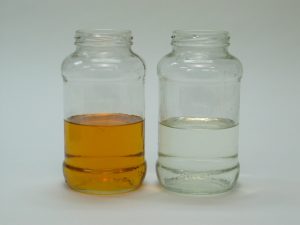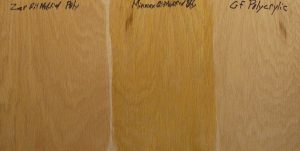We may receive a commission when you use our affiliate links. However, this does not impact our recommendations.

Both of these finishes are lacquer: nitrocellulose on the left and “water-white” on the right.
You may have come across the term “water-white” for describing finishes. It’s a little confusing. It means a finish that is totally devoid of amber coloring in liquid form. The finish looks like water in the can. It doesn’t look white.
In practice, the term is used to describe a type of lacquer, and sometimes a catalyzed (conversion) varnish. But you should be aware that water-white doesn’t necessarily mean non-yellowing. It depends on the resins used in the finish and, indeed, some so-called water-white lacquers do yellow a little as they age. The only totally non-yellowing water-white lacquer is CAB-acrylic lacquer. CAB is the acronym for cellulose acetate butyrate. So this lacquer doesn’t contain any nitrocellulose, which is the resin usually responsible for the yellowing.

The water-based finish on the right is based on acrylic resin; it has no color. The other two are oil-modified, so they have a yellowish color to different degrees.
Water-white also doesn’t mean “white in the can.” Water-based finishes, which didn’t exist when the term was created, are white in the can (though clear on the wood). Water-based finishes that are based on acrylic resin, rather than “oil-modified resin,” don’t yellow as they age. But they are not generally referred to as water-white.
Here are some supplies and tools we find essential in our everyday work around the shop. We may receive a commission from sales referred by our links; however, we have carefully selected these products for their usefulness and quality.









